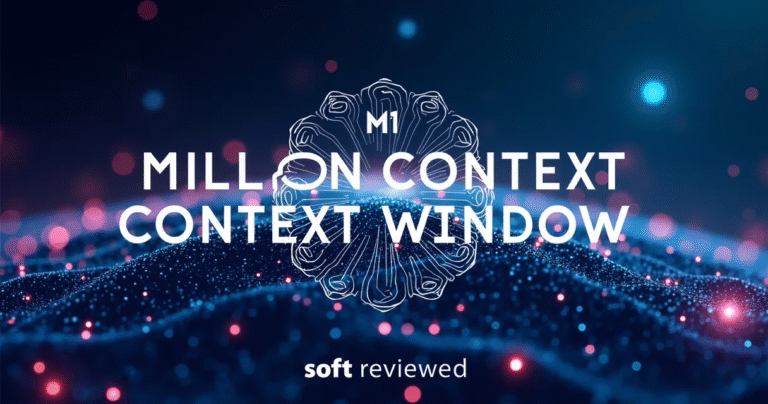🦙 Llama 4: Key Takeaways
Meta’s latest AI model breakthrough combines massive context windows with efficiency innovations
🔍 Massive Context Window
Llama 4 Scout supports up to 10 million tokens, enabling analysis of entire codebases, multi-document summaries, and long-form reasoning. This unprecedented context length allows for processing extremely long documents and conversations.
⚙️ Efficient Architectural Innovations
Mixture of Experts (MoE): Sparse architecture with 128 experts optimizes resource use, scaling performance without costly compute.
Early-Fusion Multimodality: Unified text, image, and video processing avoids disjointed pipelines for more coherent understanding.
📊 Model Specifications
Llama 4 Scout: 17B active parameters (109B total) for context-heavy tasks like document analysis.
Llama 4 Maverick: 17B active parameters (400B total) with 128 experts for chat and multilingual applications.
💼 Enterprise & Consumer Use Cases
Scout: Troubleshooting from manuals, parsing SharePoint libraries, and RAG systems.
Maverick: Multilingual chatbots, vision-supported customer support, and creative AI assistants.
💰 Cost-Effective Performance
Lower inference costs than Llama 3.3 70B, optimized for hybrid text-vision tasks. This cost efficiency makes Llama 4 more accessible for various applications while maintaining high-quality performance.
Meta Unleashes Llama 4: A New Breed of Multimodal AI Hits the Scene 🚀
The artificial intelligence space just got a major shake-up. On April 5, 2025, Meta AI pulled back the curtain on Llama 4, its latest family of advanced large language models (LLMs). This isn’t just an incremental update; Llama 4 represents a significant leap, particularly with its native multimodal capabilities – meaning it understands and processes both text and images right from the start. Packed with architectural innovations like Mixture-of-Experts (MoE) for efficiency and boasting enormous context windows, the Llama 4 series, including the currently available Llama 4 Scout and Llama 4 Maverick, aims to redefine performance and accessibility in AI. Let’s explore what makes Llama 4 tick and why it matters for developers and users alike.
What’s the Buzz About Llama 4? More Than Just Another LLM
So, what sets Llama 4 apart from the pack? At its core, it’s designed to be smarter, more efficient, and more versatile. Meta AI has focused on building models that excel not just at text generation but also at understanding visual information, reasoning, coding, and handling a vast amount of information simultaneously. This push comes amidst intense competition, positioning Llama 4 against heavyweights from Google, OpenAI, Anthropic, and emerging players like DeepSeek.
Two key innovations define this new generation: native multimodality and the MoE architecture.
Going Beyond Text: Llama 4’s Native Multimodal Smarts 🖼️+✍️
Unlike some previous models where image understanding felt bolted on, Llama 4 was built from the ground up to be multimodal. It uses an “early fusion” approach, integrating text and vision tokens seamlessly within the model’s core structure. Think of it like teaching a child language and visual recognition concurrently, rather than teaching language first and then adding picture books later.
This integrated approach allows Llama 4 to:
- 📌 Process and understand inputs containing both text and multiple images (up to 8 tested in post-training, pre-trained on up to 48).
- 📌 Perform sophisticated visual reasoning tasks.
- 📌 Ground its text responses in specific regions of an image, making interactions more precise (a strength noted particularly for Llama 4 Scout).
- 📌 Learn more effectively from diverse datasets that include text, images, and even video data.
Meta also refined the vision encoder (based on MetaCLIP but adapted specifically for Llama), enhancing how the model “sees” and interprets visual information.
Under the Hood: The Power of Mixture-of-Experts (MoE)
Efficiency is a major theme for Llama 4. Meta implemented a Mixture-of-Experts (MoE) architecture. Imagine having a large team of specialized experts instead of one giant brain trying to do everything. When a task (or token) comes in, the system routes it only to the most relevant experts.
Here’s why this matters:
- ✅ Compute Efficiency: Only a fraction of the model’s total parameters are activated for any given input. This makes both training and running the model (inference) faster and less resource-intensive.
- ✅ Higher Quality: For a given amount of computational effort during training, MoE models can often achieve better performance than traditional “dense” models where all parameters are always active.
- ✅ Scalability: It allows for building very large models (like the upcoming Behemoth) while keeping the active parameter count manageable during inference.
For example, Llama 4 Maverick has 400 billion total parameters, but only 17 billion are active at any one time during inference. This clever design makes powerful AI more feasible to deploy.
Meet the Llama 4 Herd: Scout, Maverick, and the Mighty Behemoth

The Llama 4 family isn’t one-size-fits-all. Meta has introduced a “herd” of models, starting with two available now, and a much larger one still in training.
🔍 Llama 4 Scout: The Efficient Multimodal Explorer
Llama 4 Scout is designed to be the highly capable, resource-conscious member of the family.
- Specs: 17 Billion Active Parameters (109B Total), 16 Experts.
- Standout Feature: An industry-leading 10 million token context window. This allows it to process and recall information from incredibly long documents, codebases, or user histories. Imagine summarizing multiple research papers at once or having an AI remember details from weeks of conversation.
- Efficiency: Fits on a single NVIDIA H100 GPU (using INT4 quantization), making it accessible for researchers and developers without massive compute clusters.
- Performance: Touted as the best multimodal model in its class, outperforming Gemma 3, Gemini 2.0 Flash-Lite, and Mistral 3.1 on various benchmarks. It also surpasses previous Llama generations. Its unique “iRoPE” architecture aids its long-context abilities.
🐎 Llama 4 Maverick: Balancing Power and Performance
Llama 4 Maverick steps up the performance while aiming for an excellent performance-to-cost ratio.
- Specs: 17 Billion Active Parameters (400B Total), 128 Experts.
- Context Window: 1 million tokens – still massive, suitable for most complex tasks.
- Performance: Achieves a high ELO score (1417) on the LMArena chatbot benchmark, beating models like GPT-4o and Gemini 2.0 Flash. It holds its own against the larger DeepSeek v3 on reasoning and coding tasks, despite having significantly fewer active parameters.
- Deployment: Can run on a single H100 host machine or be distributed across multiple GPUs for maximum efficiency. It’s positioned as the workhorse for Meta AI’s general assistant and chat features.
🐘 Llama 4 Behemoth: The Two-Trillion Parameter Titan (In Training)
While not yet available for download, Llama 4 Behemoth is the giant looming on the horizon.
- Specs: 288 Billion Active Parameters (~2 Trillion Total), 16 Experts.
- Role: Serves as the “teacher” model, used to distill knowledge and improve the performance of Scout and Maverick through a process called co-distillation.
- Anticipated Performance: Expected to be one of the world’s smartest LLMs, already outperforming models like GPT-4.5, Claude Sonnet 3.7, and Gemini 2.0 Pro on challenging STEM benchmarks (like MATH-500 and GPQA Diamond) even while still training.
More details about Behemoth are expected at Meta’s LlamaCon event on April 29, 2025.
Here’s a quick comparison:
| Feature | Llama 4 Scout | Llama 4 Maverick | Llama 4 Behemoth (In Training) |
|---|---|---|---|
| Active Params | 17 Billion | 17 Billion | 288 Billion |
| Total Params | 109 Billion | 400 Billion | ~2 Trillion |
| Experts | 16 | 128 (+ 1 shared) | 16 |
| Context Window | 10 Million Tokens | 1 Million Tokens | Not specified |
| Key Strength | Efficiency, Max Context, Multimodal | Best Perf/Cost Ratio, High Perf. | State-of-the-Art STEM, Teacher Model |
| GPU Needs (Min) | Single H100 (INT4) | Single H100 Host | Requires Large Scale Infrastructure |
| Availability | ✅ Available | ✅ Available | ⛔️ Not Yet Released |
The Llama 4 Training Ground: Data, Techniques, and Scale
Building models like Llama 4 requires immense resources and sophisticated techniques. Meta shared some insights into their process.
Fueling the Beast: Trillions of Tokens and Multimodal Data
The Llama 4 models were trained on a colossal dataset exceeding 30 trillion tokens – more than double the data used for Llama 3. This wasn’t just text; it included a diverse mix of:
- Publicly available text and code.
- Licensed datasets.
- Publicly shared, anonymized data from Meta platforms (like Instagram and Facebook posts).
- Image and video data (used for multimodal training).
- Data from interactions with Meta AI.
The data cutoff is August 2024. Importantly, the training corpus covered over 200 languages, with substantial data (over 1 billion tokens each) for more than 100 languages, enhancing multilingual capabilities.
Smarter Training: FP8, MetaP, and Mid-Training Enhancements
Training such massive models efficiently is crucial. Meta employed several strategies:
- ➡️ FP8 Precision: Using lower-precision floating-point numbers (FP8) during training significantly speeds up computation and reduces memory usage without sacrificing model quality. Meta achieved impressive efficiency, hitting 390 TFLOPs per GPU on a cluster of 32,000 GPUs for Behemoth.
- ➡️ MetaP Technique: A novel method developed by Meta to reliably set crucial training parameters (like learning rates), ensuring stability and good performance across different model sizes and training setups.
- ➡️ Mid-Training Refinements: The models weren’t just trained once. Meta used a “mid-training” phase to specifically enhance core capabilities, including extending the context length using specialized datasets. This is how Scout achieved its remarkable 10M token window.
Fine-Tuning Finesse: From SFT to Continuous Online RL
Pre-training creates a powerful base model, but post-training sharpens its abilities for specific tasks like conversation, instruction following, and safety. Llama 4’s post-training involved a revamped pipeline:
- Lightweight Supervised Fine-Tuning (SFT): Initial tuning on high-quality instruction-following examples. Meta found that pruning “easy” data (50% for Maverick, a staggering 95% for Behemoth!) and focusing SFT on harder examples yielded better results.
- Online Reinforcement Learning (RL): Improving the model based on feedback, focusing on harder prompts to drive significant performance gains, especially in reasoning, coding, and math.
- Continuous Online RL: An iterative process where the model is trained, used to filter prompts (keeping medium-to-hard ones), and then trained again. This proved highly effective for balancing compute cost and accuracy.
- Lightweight Direct Preference Optimization (DPO): A final step to polish the model’s response quality and handle edge cases, ensuring a good balance between intelligence and conversational ability.
This sophisticated process, especially the data pruning and continuous RL, was key to achieving the performance levels seen in Maverick and the anticipated power of Behemoth.
Putting Llama 4 to the Test: Performance Benchmarks and Real-World Impact
Benchmarks provide a standardized way to compare models, and Llama 4 puts up impressive numbers.
Scout vs. Maverick vs. The Competition: How Do They Stack Up?
- Llama 4 Scout: As mentioned, it’s positioned as the best multimodal model in its class, surpassing Llama 3.3 70B, Gemma 3, Gemini 2.0 Flash-Lite, and Mistral 3.1. Its standout feature is the 10M context window, enabling tasks previously impossible for models of this size.
- Llama 4 Maverick: Its ELO score of 1417 on LMArena places it ahead of strong competitors like GPT-4o and Gemini 2.0 Flash. It’s particularly competitive with the much larger (in active parameters) DeepSeek v3 on reasoning and coding benchmarks. This highlights its excellent performance-to-cost efficiency.
- Llama 4 Behemoth (Projected): While still training, Meta reports it already outperforms GPT-4.5, Claude Sonnet 3.7, and Gemini 2.0 Pro on demanding STEM benchmarks. Its release could set a new high bar for generally available models.
Beyond the Numbers: What Users Can Expect
While benchmarks are useful, the real impact comes from user experience.
- 💡 Enhanced Meta AI: Users interacting with Meta AI on platforms like WhatsApp, Instagram, and Messenger should notice improvements powered by Llama 4 (likely Maverick), potentially leading to more helpful, context-aware, and capable AI assistance.
- 💡 Developer Innovation: With Scout and Maverick being open-weight, developers can build sophisticated applications leveraging their multimodal capabilities, long context windows, and efficiency. This could spur innovation in areas like personalized education, advanced coding assistants, data analysis tools, and creative content generation.
- 💡 Accessibility: Scout’s ability to run on a single high-end GPU makes powerful AI more accessible to researchers, startups, and individual developers who might not have access to massive data centers.
Initial community discussions (as noted on platforms like Reddit) show excitement, though some early comparisons are being made. Users note Maverick feels like a significant upgrade, while Scout’s positioning relative to previous high-end Llama models (like 3.3 70B) is still being evaluated in real-world use.
Building Trust: Meta’s Approach to Llama 4 Safety and Bias
With great power comes great responsibility. Meta emphasizes its commitment to developing Llama 4 safely and mitigating risks like harmful content generation and bias.
Guardrails in Place: Llama Guard, Prompt Guard, and More
Meta employs a multi-layered approach to safety:
- 🛡️ Data Filtering: During pre-training, data is filtered to remove harmful content.
- 🛡️ Safety Fine-Tuning: Post-training includes specific steps using safety-focused data to align the models with usage policies.
- 🛡️ Open Source Tools: Meta provides developers with tools to implement their own safeguards:
- Llama Guard: An LLM-based filter to check inputs and outputs against customizable safety policies.
- Prompt Guard: A classifier designed to detect malicious prompts like jailbreaks or prompt injections.
- CyberSecEval: Tools and benchmarks to assess and reduce cybersecurity risks associated with generative AI.
- 🛡️ Red Teaming & GOAT: Rigorous internal testing, including automated adversarial testing using their Generative Offensive Agent Testing (GOAT) system, simulates attacks to uncover vulnerabilities more efficiently.
Tackling the Bias Challenge Head-On
LLMs can inherit biases present in their training data. Meta acknowledges this challenge and reports progress with Llama 4:
- ⬇️ Reduced Refusals: Llama 4 refuses to answer debated political or social topics far less often than Llama 3.3 (down from 7% to below 2%).
- ⚖️ More Balanced Refusals: When it does refuse, it does so more evenly across different viewpoints (unequal refusals < 1%).
- 📊 Lower Political Lean: Testing indicates Llama 4 exhibits strong political leanings at about half the rate of Llama 3.3, comparable to Grok on contentious topics.
Meta states its goal is to remove bias and enable the models to articulate different viewpoints neutrally, acknowledging that more work remains.
How Do Meta’s Llama 4 Models Compare in Performance to OpenAI’s GPT-4.1 Models?
Meta’s Llama 4 models have garnered attention for their competitive performance against OpenAI’s GPT-4. 1 models. In tasks like context understanding and creative text generation, users note nuanced differences. As the landscape evolves, openai’s latest api model release aims to set new benchmarks in the realm of AI-driven communication.
Where Can You Find Llama 4? Availability and Integration
Ready to try Llama 4 or build with it?
Getting Your Hands on the Models: Downloads and Platforms
Meta is releasing Llama 4 Scout and Llama 4 Maverick as open-weight models, continuing their commitment to open innovation.
- ✅ You can download the models directly from the official Llama website.
- ✅ They are also available on Hugging Face, a popular platform for AI models and datasets (you can typically find them under the
meta-llamaorganization). - ✅ Availability through cloud partners (like AWS, Google Cloud, Azure) and other platforms is expected to follow shortly.
This open approach allows broad access for research, development, and deployment.
Llama 4 Powering Meta AI Experiences
You don’t necessarily need to download the models yourself to experience Llama 4. Meta is integrating it into its Meta AI assistant, which is available across:
- Messenger
- Instagram Direct
- The Meta.AI website
This integration means millions of users will interact with Llama 4’s capabilities directly within the apps they already use.
Peeking Over the Horizon: What’s Next for the Llama Ecosystem?
The release of Scout and Maverick is just the beginning for the Llama 4 generation. The anticipation surrounding Llama 4 Behemoth suggests Meta is aiming for the absolute peak of AI performance.
Meta’s vision extends towards AI that can:
- 🚀 Take generalized actions in the digital world.
- 🚀 Converse more naturally and engagingly with humans.
- 🚀 Tackle complex, novel problems effectively.
Further announcements about Behemoth, the broader Llama ecosystem, and Meta’s future AI vision are expected at LlamaCon on April 29, 2025. This event will likely provide crucial insights into the trajectory of Meta’s AI development and its potential impact on both Meta’s products and the wider AI field.
Wrapping Up the Llama 4 Launch: Key Takeaways and Lingering Questions 🤔
The arrival of Llama 4 Scout and Llama 4 Maverick marks a significant moment in AI development. Key advancements include:
- 📌 Native Multimodality: Seamless integration of text and image understanding from the ground up.
- 📌 MoE Architecture: Enhanced efficiency for both training and inference.
- 📌 Massive Context Windows: Especially Scout’s 10M token capacity, opening new application possibilities.
- 📌 Strong Performance: Competitive results against leading proprietary and open models.
- 📌 Open-Weight Access: Continued commitment to fostering innovation through open releases (for Scout & Maverick).
- 📌 Integrated Safety: Multi-layered approach to safety and bias mitigation.
Llama 4 demonstrates Meta’s serious ambition in the AI race, focusing on performance, efficiency, and multimodality. While Behemoth remains the tantalizing future prospect, Scout and Maverick already offer powerful tools for developers and improved experiences for Meta users today. The coming months will reveal how the community utilizes these models and how they truly stack up against rapidly evolving competitors. One thing is clear: the pace of AI innovation shows no signs of slowing down.







